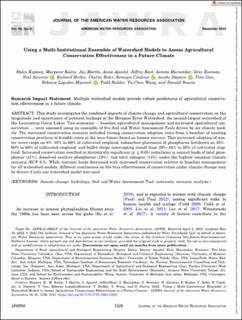| dc.contributor.author | Kujawa, Haley | |
| dc.contributor.author | Kalcic, Margaret | |
| dc.contributor.author | Martin, Jay | |
| dc.contributor.author | Apostel, Anna | |
| dc.contributor.author | Kast, Jeffrey | |
| dc.contributor.author | Murumkar, Asmita | |
| dc.contributor.author | Evenson, Grey | |
| dc.contributor.author | Aloysius, Noel | |
| dc.contributor.author | Becker, Richard | |
| dc.contributor.author | Boles, Chelsie | |
| dc.contributor.author | Confesor, Remegio | |
| dc.contributor.author | Dagnew, Awoke | |
| dc.contributor.author | Guo, Tian | |
| dc.contributor.author | Muenich, Rebecca Logsdon | |
| dc.contributor.author | Redder, Todd | |
| dc.contributor.author | Wang, Yu-Chen | |
| dc.contributor.author | Scavia, Donald | |
| dc.date.accessioned | 2023-02-23T18:57:31Z | |
| dc.date.available | 2023-02-23T18:57:31Z | |
| dc.date.created | 2022-08-16T13:28:44Z | |
| dc.date.issued | 2022-06-16 | |
| dc.identifier.citation | Journal of the American Water Resources Association. 2022, 58 (6), 1326-1340. | en_US |
| dc.identifier.issn | 1093-474X | |
| dc.identifier.uri | https://hdl.handle.net/11250/3053696 | |
| dc.description.abstract | This study investigates the combined impacts of climate change and agricultural conservation on the magnitude and uncertainty of nutrient loadings in the Maumee River Watershed, the second-largest watershed of the Laurentian Great Lakes. Two scenarios — baseline agricultural management and increased agricultural conservation — were assessed using an ensemble of five Soil and Water Assessment Tools driven by six climate models. The increased conservation scenario included raising conservation adoption rates from a baseline of existing conservation practices to feasible rates in the near future based on farmer surveys. This increased adoption of winter cover crops on 6%–10% to 60% of cultivated cropland; subsurface placement of phosphorus fertilizers on 35%–60% to 68% of cultivated cropland; and buffer strips intercepting runoff from 29%–34% to 50% of cultivated cropland. Increased conservation resulted in statistically significant (p ≤ 0.05) reductions in annual loads of total phosphorus (41%), dissolved reactive phosphorus (18%), and total nitrogen (14%) under the highest emission climate scenario (RCP 8.5). While nutrient loads decreased with increased conservation relative to baseline management for all watershed models, different conclusions on the true effectiveness of conservation under climate change may be drawn if only one watershed model was used. | en_US |
| dc.language.iso | eng | en_US |
| dc.publisher | Wiley Periodicals LLC on behalf of American Water Resources Association | en_US |
| dc.rights | Attribution-NonCommercial-NoDerivatives 4.0 Internasjonal | * |
| dc.rights.uri | http://creativecommons.org/licenses/by-nc-nd/4.0/deed.no | * |
| dc.title | Using a Multi-Institutional Ensemble of Watershed Models to Assess Agricultural Conservation Effectiveness in a Future Climate | en_US |
| dc.title.alternative | Using a Multi-Institutional Ensemble of Watershed Models to Assess Agricultural Conservation Effectiveness in a Future Climate | en_US |
| dc.type | Peer reviewed | en_US |
| dc.type | Journal article | en_US |
| dc.description.version | publishedVersion | en_US |
| dc.rights.holder | © 2022 The Authors | en_US |
| dc.source.pagenumber | 1326-1340 | en_US |
| dc.source.volume | 58 | en_US |
| dc.source.journal | Journal of the American Water Resources Association | en_US |
| dc.source.issue | 6 | en_US |
| dc.identifier.doi | 10.1111/1752-1688.13023 | |
| dc.identifier.cristin | 2043424 | |
| cristin.ispublished | true | |
| cristin.fulltext | original | |
| cristin.qualitycode | 1 | |

